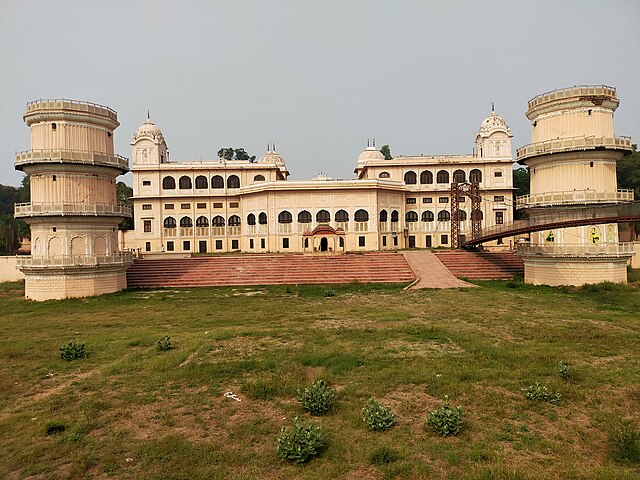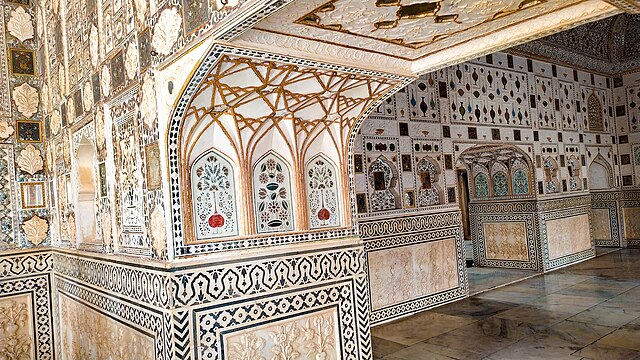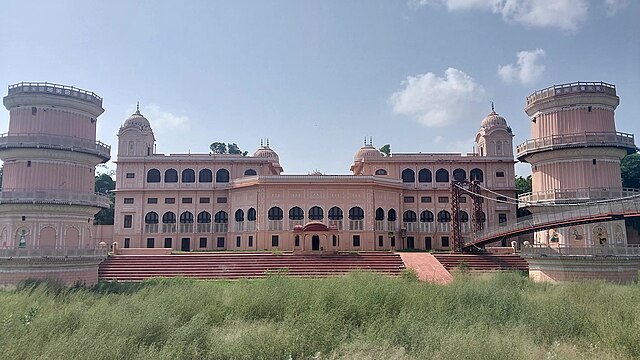Picture this: thousands of mirrors reflecting golden sunlight, creating a kaleidoscope of brilliance that dances across ornate walls. Welcome to Sheesh Mahal Patiala, where every surface tells a story of royal grandeur and artistic mastery. This isn’t just another historical monument – it’s a testament to the opulent lifestyle of Punjab’s maharajas and a masterpiece that continues to mesmerize visitors from around the world.
Located in the heart of Patiala, Punjab, Sheesh Mahal stands as one of India’s most spectacular examples of mirror work architecture. But what makes this palace so special? Why do thousands of tourists flock here every year, and what secrets lie within its glittering walls?
The Magnificent History Behind Sheesh Mahal

The story of Sheesh Mahal begins in the 19th century, during the golden age of the Patiala State. This wasn’t just any ordinary palace – it was conceived as the crown jewel of royal residences, designed to showcase the wealth and artistic sensibilities of one of India’s most powerful princely states.
Architectural Marvel of the Sikh Empire
The construction of Sheesh Mahal represents a fascinating blend of Mughal, Rajput, and European architectural styles. When you step inside, you’re not just entering a building; you’re walking into a carefully orchestrated symphony of light, color, and craftsmanship. The architects and artisans who created this masterpiece understood something profound about human psychology – that beauty has the power to elevate the soul.
Every inch of the palace was designed with meticulous attention to detail. The mirror work, known as ‘sheesh kari’ in local parlance, involves embedding thousands of small mirrors into wet plaster, creating surfaces that transform ordinary light into extraordinary visual experiences. It’s like walking inside a giant kaleidoscope where every movement creates new patterns of brilliance.
The Royal Vision of Maharaja Narinder Singh
Maharaja Narinder Singh, who ruled Patiala from 1845 to 1862, was the visionary behind this architectural wonder. He wasn’t just building a palace; he was creating a statement. In an era when British colonial influence was growing stronger, the Sheesh Mahal represented the defiant beauty of Indian craftsmanship and the enduring power of local traditions.
The maharaja understood that architecture could be a form of soft power. By creating something so beautiful that it would be remembered for centuries, he ensured that the legacy of Patiala State would endure long after political boundaries changed. And he was right – today, Sheesh Mahal continues to draw admirers from across the globe.
What Makes Sheesh Mahal Special?
What sets Sheesh Mahal apart from other historical monuments isn’t just its age or its royal connections – it’s the sheer artistry that went into its creation. This palace represents the pinnacle of decorative arts in 19th-century India, combining traditional techniques with innovative design approaches.
The Mirror Work That Takes Your Breath Away
The mirror work at Sheesh Mahal isn’t just decoration – it’s a technological marvel. Long before modern lighting systems, the palace’s designers created a natural illumination system using strategically placed mirrors. During the day, sunlight entering through carefully positioned windows gets multiplied and distributed throughout the rooms, creating an ethereal glow that seems to emanate from the walls themselves.
But here’s where it gets really interesting: the mirrors aren’t randomly placed. Each piece is positioned according to geometric principles that create specific optical effects. When candles or oil lamps were lit in the evening, the mirror work would transform the palace into a galaxy of twinkling stars. Imagine dining in a room where every surface sparkled like diamonds – that’s the kind of luxury the maharajas enjoyed every day.
The craftsmanship required for this level of mirror work is extraordinary. Artisans had to cut each mirror piece by hand, shape it to fit perfectly with its neighbors, and embed it in plaster at exactly the right angle to catch and reflect light effectively. It’s a lost art that required years of training and an eye for perfection that few possess today.
Intricate Frescoes and Artistic Details
Beyond the famous mirror work, Sheesh Mahal showcases some of the finest fresco paintings in North India. These aren’t just pretty pictures on walls – they’re visual narratives that tell stories of mythology, history, and daily life in the royal court.
European Influence in Indian Architecture
One of the most fascinating aspects of Sheesh Mahal is how it incorporates European artistic elements into traditional Indian design. You’ll notice classical columns, Renaissance-style arches, and decorative motifs that reflect the global connections of the Patiala court. This wasn’t cultural copying – it was sophisticated cultural synthesis, creating something entirely new and uniquely beautiful.
The Golden Era of Patiala State
The palace serves as a window into the golden era of Patiala State, when the maharajas were among the wealthiest rulers in India. The attention to detail in every corner of the palace reflects not just artistic vision but also the economic prosperity that made such extravagance possible. From the quality of materials used to the complexity of the decorative schemes, everything speaks of a time when resources were abundant and artistic excellence was the highest priority.
Exploring Sheesh Mahal Today

Visiting Sheesh Mahal today is like stepping into a time machine. The palace has been carefully preserved to maintain its original grandeur while making it accessible to modern visitors. But what should you expect when you visit, and how can you make the most of your experience?
What to Expect During Your Visit
Your journey through Sheesh Mahal begins the moment you enter the compound. The palace complex includes several interconnected buildings, each with its own character and artistic highlights. The main hall, with its stunning mirror work ceiling, is often the first stop that leaves visitors speechless.
As you move through the different rooms, you’ll notice how each space was designed for specific purposes. The durbar hall, where the maharaja held court, showcases power and authority through its grand proportions and rich decorations. The private chambers reveal a more intimate side of royal life, with delicate artwork and comfortable furnishings that speak of daily routines and personal preferences.
Don’t rush through your visit. This isn’t a place to hurry – it’s a place to absorb and appreciate. Take time to notice the small details: the way light plays across different surfaces throughout the day, the subtle variations in mirror patterns, the stories told through painted scenes on walls and ceilings.
Photography Guidelines and Best Spots
Photography at Sheesh Mahal can be challenging but incredibly rewarding. The mirror work creates unique lighting conditions that can make for stunning photographs if you know what you’re doing. The best photos often come from playing with natural light and reflections rather than using flash, which tends to create harsh glares on the mirrored surfaces.
Timing and Entry Information
The palace is typically open to visitors throughout the week, with specific hours that may vary by season. Morning visits often provide the best lighting conditions for photography, as the soft sunlight creates gentle reflections without overwhelming brightness. Late afternoon visits offer a different but equally beautiful experience, with golden light creating warm, romantic atmospheres throughout the rooms.
Nearby Attractions Worth Visiting
Patiala offers much more than just Sheesh Mahal. The city is home to several other historical attractions that complement your palace visit perfectly. The Qila Mubarak complex, with its impressive fortifications and royal gardens, provides context for understanding the broader scope of Patiala’s royal heritage. The Sheesh Mahal is actually part of this larger complex, so you can easily explore multiple attractions in a single visit.
Cultural Significance and Modern Relevance

Sheesh Mahal isn’t just a tourist attraction – it’s a cultural treasure that continues to inspire artists, architects, and craftspeople today. The techniques used in its construction represent knowledge systems that have been passed down through generations, and efforts to preserve these skills are crucial for maintaining India’s artistic heritage.
Preservation Efforts and Challenges
Maintaining a structure like Sheesh Mahal presents unique challenges. The mirror work is particularly delicate, susceptible to humidity, temperature changes, and physical damage. Conservation efforts require specialized knowledge and techniques that combine traditional craftsmanship with modern preservation science.
The good news is that awareness of the palace’s importance has led to significant investment in its preservation. Restoration work is ongoing, aimed at maintaining the palace’s original beauty while ensuring it can be enjoyed by future generations. These efforts involve not just government agencies but also craftspeople who still possess the traditional skills needed for authentic restoration.
The Palace in Popular Culture
Sheesh Mahal has captured imaginations far beyond its physical location. It has appeared in numerous films, documentaries, and artistic works, serving as a symbol of Indian royal grandeur. This popular culture presence helps maintain awareness of the palace’s significance and attracts new generations of visitors who want to experience its beauty firsthand.
The palace also serves as inspiration for contemporary artists and designers. Elements of its mirror work and decorative schemes appear in modern hotel designs, residential interiors, and even fashion. In this way, the artistic legacy of Sheesh Mahal continues to influence creative expression centuries after its construction.
Planning Your Trip to Patiala
If you’re planning to visit Sheesh Mahal, a little preparation can significantly enhance your experience. Patiala is well-connected by road and rail to major cities in North India, making it easily accessible for both domestic and international tourists.
Best Time to Visit
The best time to visit Sheesh Mahal depends on what kind of experience you’re seeking. Winter months (October through March) offer the most comfortable weather conditions, with pleasant temperatures that make exploring the palace complex enjoyable. Summer visits can be challenging due to intense heat, but they also offer unique photographic opportunities with dramatic lighting effects.
Monsoon season brings its own magic to the palace, with rain-washed air creating crystal-clear reflections in the mirror work. However, humidity during this period can sometimes affect visibility of the finer details, so plan accordingly.
Consider timing your visit to coincide with local festivals or cultural events. Patiala hosts several celebrations throughout the year that provide additional context for understanding the cultural significance of places like Sheesh Mahal. These events often feature traditional music, dance, and crafts demonstrations that bring the palace’s history to life.
Conclusion
Sheesh Mahal Patiala stands as more than just a beautiful building – it’s a testament to human creativity, cultural synthesis, and the enduring power of artistic vision. When Maharaja Narinder Singh commissioned this palace in the 19th century, he created something that would continue to inspire and amaze people more than 150 years later.
Every visit to Sheesh Mahal offers something new to discover. Whether you’re an architecture enthusiast, a history buff, a photography lover, or simply someone who appreciates beauty, this palace has something to offer. The mirror work creates an ever-changing display of light and reflection, ensuring that no two visits are exactly alike.
The palace serves as a bridge between past and present, showing us how artistic excellence transcends time and continues to move the human spirit. In our modern world of digital distractions and rapid change, places like Sheesh Mahal remind us of the value of craftsmanship, patience, and attention to detail.
As you plan your visit to this architectural marvel, remember that you’re not just seeing a tourist attraction – you’re experiencing a piece of living history that continues to inspire creativity and wonder. The mirrors of Sheesh Mahal don’t just reflect light; they reflect the dreams, aspirations, and artistic achievements of a remarkable civilization.
Frequently Asked Questions
1. What is the best time of day to visit Sheesh Mahal for photography?
Early morning hours (9-11 AM) provide the best natural lighting for photography at Sheesh Mahal. The soft sunlight during this time creates beautiful reflections in the mirror work without creating harsh glares. Late afternoon (4-6 PM) also offers excellent lighting with warmer tones, though it can be more crowded during these popular visiting hours.
2. How long does it typically take to explore Sheesh Mahal completely?
A thorough exploration of Sheesh Mahal typically takes 2-3 hours. This allows enough time to appreciate the intricate mirror work, read informational displays, take photographs, and absorb the historical significance of different rooms. If you’re particularly interested in architecture or photography, you might want to allow additional time for detailed observation and capturing the perfect shots.
3. Are there any restrictions on photography inside Sheesh Mahal?
Photography is generally allowed in most areas of Sheesh Mahal, but flash photography is often restricted to protect the delicate mirror work and frescoes. Some specific rooms or artifacts may have photography restrictions, so it’s best to check with the on-site staff. Professional photography equipment may require special permits or additional fees.
4. What should I wear when visiting Sheesh Mahal?
Comfortable walking shoes are essential as you’ll be exploring multiple rooms and levels. Modest clothing is recommended out of respect for the cultural significance of the site. Light-colored clothing can help you stay cool and also photographs well against the ornate backgrounds. Consider bringing a light jacket or shawl if visiting during cooler months, as the palace interiors can be quite cool.
5. Can Sheesh Mahal be visited as part of a day trip from nearby cities?
Yes, Sheesh Mahal makes an excellent day trip destination. Patiala is easily accessible from Chandigarh (about 65 km), Delhi (about 250 km), and Amritsar (about 150 km). Many visitors combine Sheesh Mahal with other attractions in Patiala like Qila Mubarak and the National Institute of Sports, making for a full day of sightseeing. Local transportation options include taxis, auto-rickshaws, and cycle-rickshaws for getting around the city.

